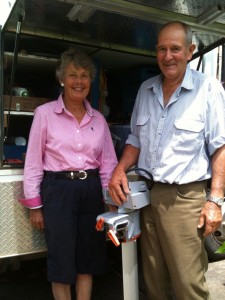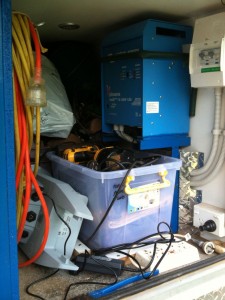It took just a quick test drive of a Torqeedo on the Zodiac around Crystal Bay to convince Tim and Jocelyn that a Travel 1003 would be ideal match for their inflatable dinghy which they carry in their motorhome. Well, its not really a motorhome—with 1500 watts of solar panels on the roof its a mobile power station! (Take it from me, thats a lot of power—my yacht, Current Sunshine has only 460 watts and on sunny days its quite enough but rainy weather it struggles. With 1500 watts, they don’t have to skimp even on the cloudiest of days).
They’re travelling south just now and next year they’ll be joining the winter migration that happens each April as the grey-nomads head for northern Australia’s dry season.
On board their RV they carry a folded inflatable dinghy and want to be able to explore the pristine rivers and billabongs they come across in their travels. So the Torqeedo 1003 fits the bill nicely.
It has a lot of advantages for this kind of travel and can be easily recharged by plugging into their on-board inverter. This makes the Torqeedo a solar powered motor because the charge will come from their battery bank—because they have plenty of solar panels they never need to plug into mains power.
Not having to carry petrol for the outboard appeals to Tim because the motorhome is diesel powered. And the electric outboard cab be stowed anywhere in the RV that there is a suitable space. Because it is clean and slim, it can easily be stowed in a cupboard with linen or other domestic items that would not want to be in contact with a smelly petrol motor.
I hope we hear from Tim and Jocelyn with some photos of them in their dinghy on an adventure in some remote place…






This looks really good – I’m wondering how big an inflatable this motor will push along?
Best thing is that, (unlike battery cars which seem to just shift the pollution back to the (mostly) coal-fired power station) Tim and Jocelyn get the power for their boat battery directly from our closest star – no nasty, black (C) footprints on their carpet – brilliant! 🙂
Just pondering whether it mightn’t be more efficient to charge the battery directly from the solar panels rather than via battery-bank: inverter: boat battery charging adaptor?
Hi there,
I haven’t tried it on a bigger inflatable. How big do you have in mind? I think the more telling thing might be how many people you plan to carry.
Before Tim and Jocelyn bought this motor they tried it out on my zodiac and there were four of us on board—they’d brought a friend along. What I suspect is that with such a load a larger inflatable would probably have presented a better wetted shape and could have been faster.
What I mean is that as the inflatable sits lower in the water it becomes more like a blunt shape and would be harder to push. But with more area of a bigger inflatable, it would sit higher.
But really the best way is to do a trial. Where are you? Would you like to try one on your inflatable so we can know for sure?
And on the topic of charging the battery, because they have plenty of power available they already have a situation where the charge controller will shut down the output from their solar panels as the batteries reach full charge, and that extra capacity is, shall we say, wasted. So its really of no consequence that this method may be slightly less efficient than direct charging. Its using power that otherwise would be wasted anyway.
And its just a lot easier to manage this way.
Cheers
Chris